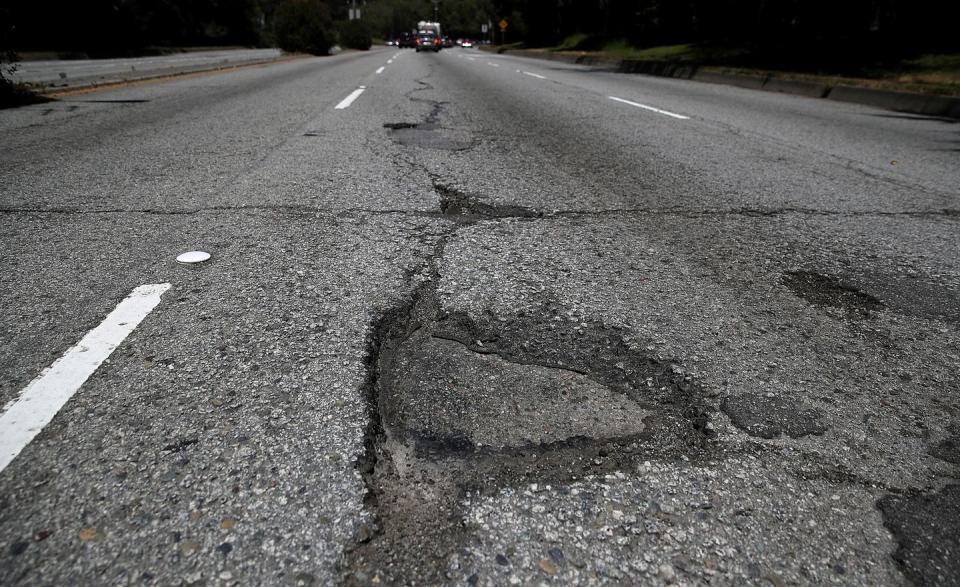Falling Gas-Tax Revenues Can't Keep Up with Rising Road Repair Costs

The need to repair America's roads and bridges keeps growing while revenue, primarily from taxes on fuel sales, has been dropping, mostly because cars have become more fuel-efficient. The shrinking revenue still goes toward repairing the roads, but federal and state income haven't kept up. These taxes are mostly fixed rates rather than a percentage per-gallon, and therefore don't rise with inflation.
Since the federal gas tax was last increased in 1993, the fuel economy of new passenger vehicles has improved from an average 20.5 mpg to over 26 mpg, according to the U.S. Department of Energy. Although the number of cars and the total miles driven have risen, annual revenues from the federal excise tax on fuel have been declining since 2007.
The same is happening with state fuel taxes, of course, but many states have started to adapt to this; 27 have either raised or reformed their gas taxes since 2013, and road repair is a hot topic for candidates running for state office this election season.
In Iowa, a 10-cent-per-gallon hike enacted in 2015 has already stepped up the timelines for hundreds of state projects. And Georgia’s system links its gas tax to inflation. (The alternative of taxing as a percentage of the sales price has been widely rejected because it would make revenues as volatile as gas prices; it's hard to plan infrastructure spending for years in advance if you can't reliably project the income.) State highway funds also have proven easy for legislators to raid to cover budget gaps elsewhere. On the other hand, some states such as Oklahoma have repeatedly diverted general-fund money to fix roads. Oklahoma recently raised its gas tax, however, using the equivalent amount formerly drawn from the general fund to give teachers a raise. Other states are moving to prevent raids, designating gas tax funds for transportation spending only.
The need to repair and upgrade infrastructure across America is clear, and it's one of the few governmental priorities that a majority of both Republican and Democratic voters agree upon. The American Society of Civil Engineers gives our roadway infrastructure a grade of D, for poor. “Currently, 32 percent of America’s major roads are in poor or mediocre condition,” the ASCE said in its 2013 report card. Nearly half-47 percent-of miles traveled are on urban roads that the group classifies as poor. Such degraded pavement costs the average motorist $324 a year in repairs and operating costs, totaling $67 billion per year, money that might be better spent on fixing the roads rather than our cars.

Few states have done much to address a seeming inevitability: the tiny but fast-rising proportion of electric vehicles, which pay no gasoline tax toward road repair and yet have been subsidized with rebates to buyers on the federal level and in many states. Only 19 states have enacted EV fees to help pay for roads, with Georgia charging the most. Pay-per-mile scenarios like the one in Oregon (thus far voluntary, with a corresponding rebate to cover taxes drivers pay at the pump) track vehicle mileage, essentially making every road a toll road. This is seen as one way to refill road-fund coffers and level out the cost-sharing between gasoline and electric cars. Another approach is to raise registration and licensing fees to cover road maintenance costs, another means of sharing the burden irrespective of the energy source propelling the car.
The mother ship, the federal Highway Trust Fund, is expected to be insolvent by 2021, however. The federal excise tax on gas has been fixed at 18.4 cents per gallon (24.4 cents for diesel fuel) since 1993. In their 2016 election campaigns, both presidential candidates promised to fix America's infrastructure, with Democrat Hillary Clinton pledging to add $275 billion in spending, an amount President Donald Trump doubled with a $550 billion pledge (sometimes, he even said he'd invest $1 trillion, though a large part would go toward upgrading other infrastructure, such as water and sewer systems). Politifact rates that promise as "stalled," despite the president's efforts so far.
In February, just as he was announcing a $200 billion 2018 infrastructure spending plan, President Trump endorsed a 25-cent-per-gallon increase to support future expenditures-drawing much opposition from his party. So nothing came of that proposal. The clock is ticking and roads are like our cars-the longer maintenance is deferred, the more it costs in the end.
('You Might Also Like',)

 Yahoo Autos
Yahoo Autos 